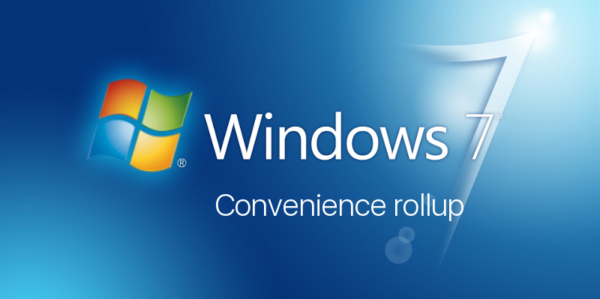RECOMMENDED:
Every time you do a fresh install of Windows 7, even if your ISO
file has Service Pack 1 integrated, it takes ages to install all
available updates. So, reinstalling becomes a nightmare for those who
use the genuine installation media of Windows 7 SP1. Microsoft has
decided to change this situation and has released a convenience rollup
for Windows 7 SP1 which will save your time.
The convenience rollup package acts like a Service Pack 2 for Windows 7 and includes all security patches and almost all the non-security updates for operating system core components released after Windows 7 SP1. This package is cumulative meaning once you install it you won't have to install updates released up to April 2016. The update is released under ID KB3125574.
For existing users who have an up-to-date Windows 7 installed on their PC, the convenience update (KB3125574) is optional, since all the security updates contained in this update and some optional non-security updates should already be installed on your PC via Windows Update.
To apply this update, you must have installed the April 2015 servicing stack update for Windows 7 (KB3020369). For most users, it will be already installed.
Download Windows 7 Convenience rollup
Windows 7 Convenience rollup direct download links
Alternatively, you can download it using these direct download links:
First, see how to determine if you are running 32-bit Windows or 64-bit.
That's it.
Thread Source
The convenience rollup package acts like a Service Pack 2 for Windows 7 and includes all security patches and almost all the non-security updates for operating system core components released after Windows 7 SP1. This package is cumulative meaning once you install it you won't have to install updates released up to April 2016. The update is released under ID KB3125574.
For existing users who have an up-to-date Windows 7 installed on their PC, the convenience update (KB3125574) is optional, since all the security updates contained in this update and some optional non-security updates should already be installed on your PC via Windows Update.
To apply this update, you must have installed the April 2015 servicing stack update for Windows 7 (KB3020369). For most users, it will be already installed.
Download Windows 7 Convenience rollup
Windows 7 Convenience rollup (KB3125574) can be installed from the Windows Update Catalog. The Windows Update Catalog website can only be used from Internet Explorer. Open the following hyperlink in IE:Download Windows 7 Convenience rollup
Windows 7 Convenience rollup direct download links
Alternatively, you can download it using these direct download links:
- Windows 7 Convenience rollup for 32-bit operating system
- Windows 7 Convenience rollup for 64-bit operating system
Integrate/Slipstream Windows 7 Convenience rollup into SP1 ISO
While the update can be installed directly after installing Windows 7 SP1 and KB3020369, interested users can rebuild the installation media and integrate the update into it. It can be done like this:First, see how to determine if you are running 32-bit Windows or 64-bit.
- Copy all the files from Windows 7 SP1 setup media to a folder, let's say it will be C:\ISO\Win7SP1.
- Open an elevated command prompt.
- At an elevated command prompt, type the following command:
Dism /Get-WIMInfo /WimFile:C:\ISO\Win7SP1\sources\install.wim
An index or name value is required for most operations that specify a Windows imaging (WIM) file. - Type the following command to mount the offline Windows image.
Dism /Mount-WIM /WimFile:C:\ISO\Win7SP1\sources\install.wim /Name:"Windows 7 Ultimate" /MountDir:C:\ISO\unpacked
This command will mount the Windows 7 SP1 Ultimate edition files to the folder C:\ISO\unpacked. The folder must exist on your system, otherwise correct the path. - Type the following command to integrate KB3020369 for Windows 7 64-bit
Dism /Image:C:\ISO\unpacked /Add-Package /PackagePath:C:\packages\Windows6.1-KB3020369-x64.msu
For 32-bit Windows 7, type the following command
Dism /Image:C:\ISO\unpacked /Add-Package /PackagePath:C:\packages\Windows6.1-KB3020369-x86.msu
Correct the file paths and file names as necessary. I used the actual paths and file names on my computer as an example. - Now, type the following command to add the KB3125574 package to the image. Do it as follows.
For 32-bit Windows 7 SP1, execute this command:Dism /Image:C:\ISO\unpacked /Add-Package /PackagePath:C:\packages\windows6.1-kb3125574-v4-x86_ba1ff5537312561795cc04db0b02fbb0a74b2cbd.msu
For 64-bit Windows 7 SP1, execute this command:
Dism /Image:C:\ISO\unpacked /Add-Package /PackagePath:C:\packages\windows6.1-kb3125574-v4-x64_2dafb1d203c8964239af3048b5dd4b1264cd93b9.msu
Again, correct the file paths and file names as necessary. I used the actual paths and file names on my computer as an example. - Once this is done, type the following command to commit the changes and unmount the image.
Dism /Unmount-WIM /MountDir:C:\ISO\unpacked /Commit
That's it.
Thread Source

No comments:
Post a Comment